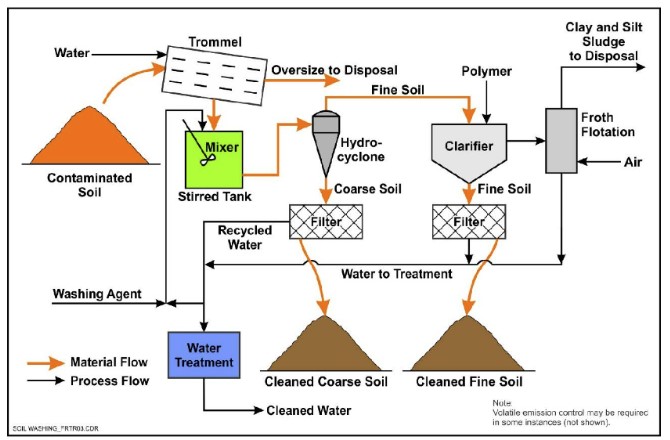Comprehensive PFAS Management Strategies for Contaminated Sites
Wiki Article
Advanced Methods for Effective PFAS Contamination Removal
The relentless challenge of PFAS contamination demands the exploration of advanced removal approaches that can effectively deal with these damaging substances. Ingenious innovations, such as innovative oxidation processes and different adsorption techniques, have actually become promising remedies in mitigating PFAS from impacted settings. Moreover, the function of regulative structures fit these innovations can not be overlooked, as they dictate the rate and instructions of remediation initiatives. As we analyze these innovative methods, it comes to be important to evaluate their useful applications and the broader ramifications for ecological health and wellness and plan.Comprehending PFAS Properties
Although per- and polyfluoroalkyl substances (PFAS) have actually been extensively utilized in numerous commercial and consumer products as a result of their distinct buildings, their perseverance in the atmosphere positions significant obstacles to public health and wellness and safety. PFAS are a team of artificial chemicals characterized by a carbon-fluorine bond, among the best chemical bonds known, which adds to their phenomenal security and resistance to degradation. This security enables PFAS to accumulate in the setting and living microorganisms, causing potential adverse wellness results.These exact same properties contribute to their ecological determination, as PFAS do not conveniently damage down via natural processes. Recognizing the chemical buildings of PFAS is essential for developing reliable strategies to manage and mitigate their environmental effect.
Innovative Removal Technologies
The perseverance of PFAS in the setting has stimulated the growth of cutting-edge removal innovations focused on efficiently removing these contaminants from influenced ecosystems. Amongst one of the most appealing methods are advanced oxidation procedures (AOPs), which use powerful oxidants to break down PFAS substances right into less hazardous substances. AOPs can be customized to target details PFAS frameworks, enhancing their efficacy.An additional arising innovation is the use of adsorption media, such as activated carbon and ion exchange resins, which can uniquely record PFAS from infected water. These products have actually revealed considerable removal performances, although regular replacement and regeneration are required to preserve efficiency.
Membrane layer filtering strategies, consisting of reverse osmosis and nanofiltration, are also acquiring grip in PFAS removal. These methods can properly divide PFAS from water, providing a sensible remedy for treating polluted resources. Furthermore, thermal treatment techniques, such as incineration, can decompose PFAS into non-toxic results, though they require cautious management to regulate emissions.
Jointly, these innovative removal technologies represent considerable innovations in the recurring fight versus PFAS contamination, providing numerous techniques to recover affected settings and shield public health and wellness.

Bioremediation Methods
Bioremediation techniques supply an appealing approach to resolving PFAS contamination by taking advantage of the natural capacities of bacteria to weaken these persistent substances (m270 waste management). This method includes making use of germs, fungis, and other microbes that can metabolize or transform PFAS materials right into much less damaging byproductsCurrent advancements in molecular biology and ecological microbiology have improved our understanding of microbial areas and their potential functions in PFAS degradation. Researchers are proactively exploring certain pressures of bacteria, such as Pseudomonas and Bacillus, which have actually shown the ability to damage down certain PFAS substances.
In situ bioremediation methods, where microorganisms are promoted directly in infected environments, can be especially effective. This strategy typically involves the application of nutrients or electron contributors to promote microbial growth and task. Furthermore, ex situ methods, such as bioreactors, permit controlled problems that can optimize deterioration prices.
In spite of the guarantee of bioremediation, obstacles stay, consisting of the complicated nature of PFAS compounds and the requirement for extensive field screening - m270 waste management. Proceeded r & d will certainly be vital to improve these methods and evaluate their performance in varied environmental contexts
Adsorption and Filtering Approaches
Addressing PFAS contamination commonly entails employing adsorption and filtration techniques, which are made to get rid of these persistent chemicals from water and soil. Among the numerous strategies, activated carbon adsorption is commonly used because of its high surface location and porosity, making it possible for reliable capturing of PFAS molecules. Granular triggered carbon (GAC) systems are especially preferred for dealing with huge quantities of infected water, while powdered turned on carbon (PAC) can be utilized for smaller-scale applications.Ion exchange resins likewise reveal assurance in PFAS elimination, functioning by exchanging PFAS ions with less More hints damaging ions in the water. This technique has demonstrated effectiveness in focusing PFAS substances, promoting their succeeding elimination. In addition, membrane layer filtration techniques, such as reverse osmosis and nanofiltration, run by utilizing semi-permeable membrane layers to different PFAS from water, efficiently lowering their concentrations.
While these approaches are reliable, they should be thoroughly picked based on the specific PFAS substances existing and the environmental context. Continual developments in materials go scientific research and engineering are bring about the advancement of unique adsorbents and filtering systems that boost removal efficiencies and reduce operational prices, consequently enhancing general removal efforts.
Regulatory and Plan Considerations
Just how can effective governing frameworks improve the monitoring of PFAS contamination? Thorough policies are necessary to make sure a coordinated and robust action to the challenges positioned by per- and polyfluoroalkyl materials (PFAS) Regulations can establish clear guidelines for surveillance, reporting, and remediating PFAS-contaminated websites, fostering responsibility amongst industries and public entities. (m270 waste management)
Additionally, economic incentives and gives can be incorporated into plans to urge the fostering of advanced remediation innovations. Policymakers need to also prioritize study and growth, guaranteeing that arising methods for PFAS elimination are confirmed and carried out effectively.
Additionally, public awareness and interaction are critical elements of any regulative strategy, empowering areas to advocate for their health and wellness. Inevitably, a well-structured governing environment their explanation will not only improve the monitoring of PFAS contamination but also promote lasting methods that secure future generations.
Verdict
In recap, the intricacy of PFAS contamination necessitates the adoption of advanced removal approaches. Continued study and advancement in this area continue to be essential to resolving the difficulties presented by PFAS contamination.Report this wiki page